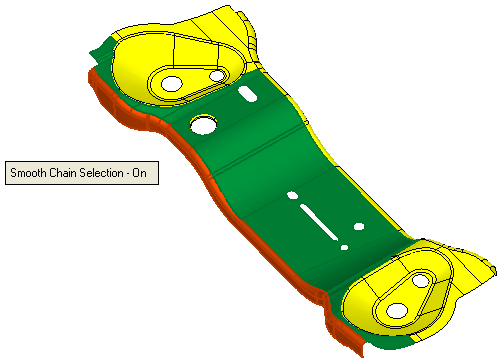|
|
Auto Blank on Binder  : Options and Results
: Options and Results
Access: Open this function from one of the following locations:
-
Select Die Design > Geometry Manipulation > Auto Blank on Binder from the menu bar.
-
Select Geometry Manipulation > Auto Blank on Binder from the following Die Design Guide: Die Process Design Guide (Forming).
Blank a set of adjacent stitched and skinned faces on the extension of other sets of planar and cylindrical faces, using finite element analysis (FEA).
The function is similar to the Local Blank and Blank On Binder functions; however, in this case the fixed faces do not only consist of planar faces. This function uses a finite element enginefinite element engine.
The Finite Element Analysis (FEA) engine used in the DieDesign application is based on technology supplied by the Forming Technologies Inc (FTI) 3rd party engine. For additional information on FTI, see www.forming.com.
The finite element engine is used in the following functions:
Whenever the finite element engine is used, resultant forces are calculated and stored for usage in the Die Forces operation.
Force Calculation: The force calculation employed depends on the type of operation being calculated. For additional information and to define some of the values used in force calculations, see the Die Force Calculation Preferences.
Correction Factor: A Die Preference option enables the setting of a default Correction Factor to manipulate forces calculated by the finite element engine. The forces displayed in the above mentioned functions will be multiplied by this factor.
Required Step 1 
- Pick the reference (fixed) faces.
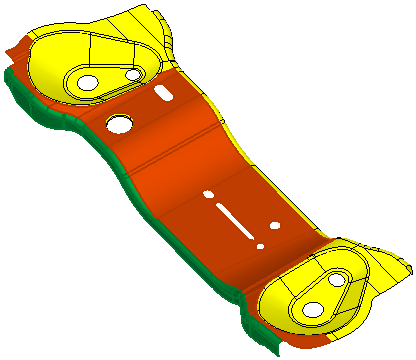
Required Step 2 
- Pick the faces to blank. Pick the required faces to blank (marked in red ) over the extension of the faces that were selected in step 1 above.
The system automatically identifies (and selects) all the faces adjacent smooth faces. - If required, you can deselect these faces manually,
Required Step 3 
- Set the parameters. efine the required parameters.
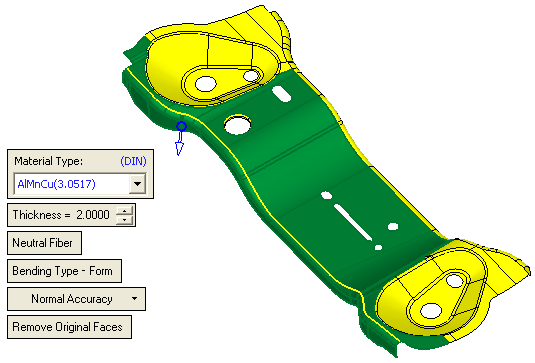
Some of these parameters are common to other functions. See the parameter explanations of these parameters under the Blank function.
In addition to the above parameters, the following parameter also appears in the Auto Blank on Binder function:Remove Original Faces
This is a toggle option - Remove Original Faces / Keep Original FacesRemove Original Faces / Keep Original Faces. When the default Remove Original Faces is selected, the original faces are removed, as shown here and in the results of the procedure below. When toggled Keep Original Faces is selected the original faces are maintained.
Remove Original Faces
Keep Original Faces
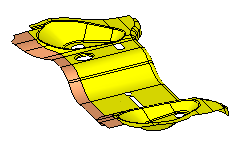

Note: If required you can click the blue arrow to change the direction of the local blank operation.
- Exit.Exit.
Optional Step 1 
- Pick the points to be transferred. For further details on the points to be transferred, refer to the same option in the Blank function.
Optional Step 2 
- Show the analysis results. This step is identical to the appropriate options in the Show Analysis function.

Optional Step 3 
- Change the tipping direction. For further details on changing the tipping direction, refer to the same option in the Blank on Binder function.
- Click OKOK or ApplyApply in the Feature Guide to complete the function.
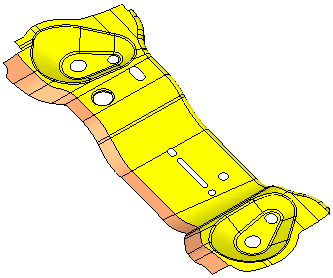
- When completed, the Auto Blank on Binder feature will appear in the Feature Tree

Additional ExampleAdditional ExampleRequired Step 1
 : Pick the Binder Faces
: Pick the Binder Faces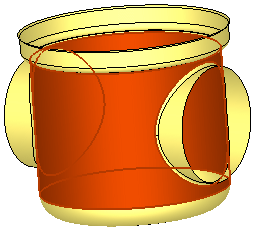
Required Step 2
 : Pick Faces to Blank
: Pick Faces to BlankPick the required faces to blank (marked in red ) over the extension of the faces that were selected in Step 1 above.
The system automatically identifies (and selects) all the faces adjacent smooth faces. If required, you can unselect these faces manually,

Required Step 3
 : Set the Parameters
: Set the Parameters 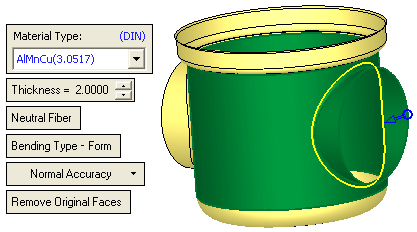
Define the required parameters as described in the Step 3 of the previous example, then <exit><exit>:
Optional Step 1
 : Pick the Points to be Transferred
: Pick the Points to be TransferredFor further details on the points to be transferred, refer to the Blank tool.
Optional Step 2
 : Show Analysis Results
: Show Analysis ResultsThis step is identical to the Show Analysis function.
Press OK
 or Apply
or Apply  in the Feature Guide to complete the function,
in the Feature Guide to complete the function, 
|


